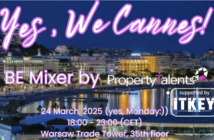- The role of alternative funding sources grew significantly during the recession
- Crowdfunding can bridge startups with even wider communities today than before
- Debt funding is often overlooked by founders who are unaware that they don’t always need to be profitable to use it
- The winners of 2024 are those who can diversify their funding sources
On May 8-9th, La Valletta’s Mediterranean Conference Centre welcomed the EU-Startups Summit for the very first time. For its 10th anniversary, the Summit put together a particularly impressive list of international thought-leading speakers from top-tier companies, funds, and other organizations.
ITKeyMedia spotlights the panel discussion on Alternative Funding Strategies for Startups. The participants were:
- Bart Becks, Board Member at European Innovation Council
- Clement Bigot, Investment Director at Seedrs
- Melanie Dufour, CFO at Re:cap
- Regina Lau, CFO at Weavr
In view of the recent recession, funding methods beyond traditional venture capital began to attract more and more attention from startup founders. To start off the discussion, the speakers shared their outlook on the funding process today.
Choosing the Funding Method Today

Melanie Dufour, CFO at Re:cap
Ms Dufour said the tone by stating that in times when traditional funding becomes more difficult, the importance of alternative funding sources grows. Even when raising venture funding remains a good idea, another good idea is diversifying the sources of investment. The alternative instruments can range all the way to public grants.
Since Re:Cap deals with debt capital, Ms Dufour chose to talk about crowd equity. The big question is – Which directions to follow? She suggests the ‘political’ – even though not satisfying – answer: It depends. There are various factors to keep in mind when structuring the capital stock.
For example, if the startup is pre-product or the product cycle is fairly long, then it is particularly important to look at different instruments. R&D-heavy projects should probably prioritize venture capital and public grants over debt.
Another factor is how fast the company wants to grow. Projects that are focused on speedy growth find it difficult to remain bootstrapped (even though many succeed this way) and need to look for external financing, including equity and loans in various combinations.
Qualitative aspect also plays a significant part in structuring the capital stack, i.e. how much money and external influence a startup should accept when raising venture capital. That is not to forget about the expectations that one has to fulfill.
As a debt provider, Re:Cap has to explain a company’s benefits of raising debt even before it becomes profitable. This is because founders treat debt providers as banks without seeing the difference between the two, and banks don’t give debt to someone who isn’t profitable. For debt providers, on the other hand, the critical issue is how predictable the revenue and potential profit are.
Crowd and Community

Clement Bigot, Investment Director at Seedrs
In Mr Bigot’s view, there were never as many various sources of funding as there are today. Therefore, the first thing to do when raising capital is to go out to the market and see what’s available and what’s best for one’s goals. As a crowd investment platform, Seedrs’ advantage in this regard is the community. This is especially important today, when money is more expensive than it used to be, and retail investors pay much more attention to profitability. Also, it is difficult to overestimate a company’s ability to bring its own community into the investment round.
Mr Becks added that the uniqueness of crowd investment is the opportunity to combine different sources within one round. Nevertheless, a successful crowdfunding campaign demands an exciting story that can entice a community.
Ms Lau agreed that the elements of marketing and PR are often overlooked in crowdfunding campaigns. She suggested an equation: Crowdfunding = Dollars + Community Engagement = Market Presence + PR + Product-Market Fit Validation. Ultimately, these are the levers regardless of the sought source of funding. For early-stage, it means to prove that a product is viable, i.e. better than just a great idea. A crucial element for that is having actual attention on oneself, i.e. being present in the marketplace.
What Makes a Product Worth Funding
Ms Dufour reiterated that the main factor is recurrent revenue, i.e. against what a company can borrow. In Re:Cap’s experience, this is most often the case with B2B SaaS companies. As for the profits, debt can help a company bridge the time when it gets to this point. The speaker also pointed out that 19 months prior, companies primarily sought debt for growth, but now more companies seek it for continuity.
From the crowdfunding perspective, Mr Bigot added that the product needs to be in the right market – otherwise, it would be impossible to build a convincing narrative to attract a community. In view of the economic circumstances, each given individual can invest less than they used to, which means that raising the thought amount requires expanding the community (incl. geographically), which – in turn – raises the importance of a universally convincing narrative.

Bart Becks, Board Member at European Innovation Council
Speaking of geography, Mr Bigot reminded that since the European Crowdfunding Regulation came out a couple of years ago, crowdfunding entities like Seedrs were granted a framework within which they can be active all across Europe without having to adjust to national legislation. This naturally increases the choice of crowd investment platforms for startups. As for Seedrs, its huge advantage is that it is also active in the US, which suggests an apparent bridge.
Seeing how the European Innovation Council is the biggest deep tech investor on the continent, Mr Becks was asked about how startups could leverage EIC’s support. Indeed, an organization like EIC would normally not be expected to invest directly in companies – but it does. Mr Becks reminded that EIC actually supports startups across three stages: research, incorporation, and acceleration. According to Mr Becks, the purpose is to ‘set up an entrepreneur’s journey’ and facilitate further fundraising (and participate in it). As such, EIC primarily looks at startups who will be able to attract multiple investors or possibly even multiple sources of funding.
From 2024 and Onward

Regina Lau, CFO at Weavr
Looking into the future, Ms Lau said that quite a few expectations for 2024 haven’t quite happened – such reduced inflation, among others. This speaks in favor of survival of the fittest, i.e. the startups that are capable of leveraging multiple sources of funding and can boast about exceptional financial discipline.
Ms Lau’s other observation was that the dire circumstances have forced many aspiring companies into partnerships, which increased the quality of what they’re doing. Namely, joining forces with the right partner can liberate one from the necessity to build the tech stack from the ground up and focus on more specific aspects, which adds to the ultimate quality and actual innovation, proving that one plus one often equals three.

Kostiantyn is a freelance writer from Crimea but based in Lviv. He loves writing about IT and high tech because those topics are always upbeat and he’s an inherent optimist!





